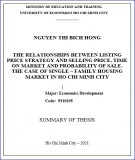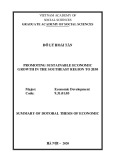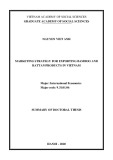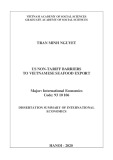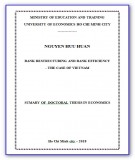MINISTRY OF EDUCATION AND TRAINING UNIVERSITY OF ECONOMICS HOCHIMINHCITY -----------------
TRAN THI TRANG
FACTORS INFLUENCING FRANCHISEE’S INTENTION TO MAINTAIN PARTICIPATION IN THE FRANCHISE SYSTEM IN HO CHI MINH
CITY
Major: Commercial Economics
Code: 62.34.01.21
THESIS SUMARY
Ho Chi Minh City –2018
The Thesis was completed in: University of Economics HCMC
Tutors:
1. Professor Vo Thanh Thu
2. Ph.D Ta Thi My Linh
Opponent 1:
Opponent 2:
Opponent 3:
The thesis will be protected in front of the Council at:
At ……… h ……… Date ……… Month ……… Year
The thesis can be found at:
LIST OF RESEARCH PAPERS
A. Key research papers relate to the thesis
1. Tran Thi Trang, 2016. Factors Influencing Franchisee’s Intention to Maintain Participation in the Franchise System: Case in Viet Nam. Journal of Science and Technology. No. 8(105), page 108-112.
2. Tran Thi Trang, 2016. The effect of commitment and franchising law enforcement on franchisee's intentions to remain in the franchise system. Proceedings of the 5th International conference on emerging challenges: partnership enhancement. ISBN: 978-604-93-8961-0, page 111-116.
the Franchise System.
3. Vo Thanh Thu & Tran Thi Trang, 2015. Influence of Quality Relationship and Big Five Factors to Decision of Intention to Maintain Participation Journal of Economics in Development. No.10, P.92-110.
B. Other research papers relate to the thesis
4. Tran Thi Trang, 2015. The State Management to Franchise Activities and
Recommendations. Review of Finance. No. 611, page 20-22.
5. Vo Thanh Thu, Tran Thi Trang & etc., 2015. Franchising in Ho Chi Minh city - Problems and Solutions to promote development. Research project (Department of Science and Technology Ho Chi Minh City).
6. Nguyen Dong Phong, Vo Thanh Thu & Tran Thi Trang, 2015. Franchise
Business Guide. UEH Publising House.
7. Tran Thi Trang and Vo Thanh Thu, 2015. Franchising – Problems and recommendation. Proceedings of the 5th International conference on emerging challenges: Managing to Success. ISBN: 978-604-938-723-4, page 473-480.
8. Tran Thi Trang, 2014. Service quality in convenience franchising stores. Proceedings of the 5th International conference on Green Technology and Sustainable Development. ISBN: 978-604-732817-8, page 650-654
1
CHAPTER 1: INTRODUCTION
1.1. Theoretical background
There have existed numerous scholarly studies on the
maintenance and development of franchising but most authors argue
that profitability and business performance are common goals and
interests which both franchisors and franchisees concern about.
These are also the most important factors to maintain a relationship
since the loss of one party will negatively affect the other and vice
versa. Other scientists claim that the quality of franchise maintenance
and development depends on the quality of the relationship between
Franchisee - Franchisor (Rubin, 1978; Shane, 1996). This
relationship is characterized by the following three elements: (1) The
quality of the franchise contract that stipulates the responsibilities,
the right to decide and the sharing of resources between the
franchisor and franchisee (Rubin, 1978; Pizanti et al., 2003), (2) The
development of relationship between Franchisee - Franchisee and (3)
The relationship quality in franchise operations depends highly on
Franchisee (Kaufmann et al., 1995, Nathan, 2004).
Despite different opinions about franchise, the scientists all
agree some common characteristics: Franchise business model helps
quickly expand business scale and develop brand through
Franchisees’ investment in the system and thus a franchise system
needs to be stable and grow in terms of the number of Franchisees.
Choosing Franchisees with sufficient financial capacity, management
capacity to participate in a franchise system is very essential.
Theorists in franchising are also interested in exploring how these
Franchisees continue to maintain a symbiotic relationship and the
cooperation - building - development of franchise system. This is an
2
important issue, vital for the development of a franchise system.
There are many studies on maintaining the cooperation in business in
general and maintaining participation in the franchise system in
particular such as Adeiza et al. (2017), Erlinda et al. (2016), Jena et
al. (2011), Hanafiah (2009) , Lee et al. (2008), Venetis et al. (2004),
Ulaga et al. (2006), Chiou et al. (2004), Morrison (1997),...
In franchise operations, for Franchisor, Franchisee is both a
customer and a member of franchise system. Therefore, unlike
normal business activities, the customers (the franchisees) need to be
carefully selected so that they can participate in the long-term
development of the franchise system. Factors influencing
Franchisee's intention to maintain participation in the franchise
system in the above mentioned studies are primarily associated with
the relationship between Franchisor - Franchisee (trust, satisfaction,
commitment), and intention to maintain participation in the franchise
system of the Franchisee is indeed the result of this relationship. In
addition, there are other factors that affect the intention to maintain
the Franchisee's participation in the franchise system such as
Communication, Service Support of Franchisor, Competitive
Advantage of Franchisor, Commitment of franchise system,
Relationship between Franchisor and Franchisee, Satisfaction,
Individual Characteristics of Franchisee,... However, the above
authors failed to mention legal factors of franchising as well as how
Franchisee’s legal implementation affects the Franchisee' intention to
maintain participation in the franchise system. Besides that, the
individual characteristics of Franchisee and quality of relationship
between Franchisor and Franchisee are mentioned separately to study
influences on the intention to maintain participation in the franchise
3
system. Individual characteristics of Franchisee are related to the
selection of Franchisee of Franchisor for the franchise system.
Simultaneously, in a franchise system, there is not only the
Franchisor-Franchise relationship but also the relationships between
franchisees. Hence, correlation between individual characteristics,
quality of relationship between Franchisor and Franchisee and
intention to maintain participation in franchise system are issues that
need be studied more clearly. Moreover, in developing countries like
Vietnam, culture, language, law, people, income, living standards, ...
are different from developed countries. Therefore, in franchise
operations, intentions to maintain Franchisee’s participation in
franchise system will have common features but there may exist
particular factors, which also need to be further explored through the
scholarly studies and tested through empirical studies.
Franchising is a business model that plays an important role in
creating jobs and contributes to economic development (Shane et al.,
2006). The franchise business model is applied in various business
fields such as restaurants, hotel services, retails, personal services,
automobiles, real estates, commercial services,... In Vietnam, namely
in Ho Chi Minh City, franchise business is in the early stage of
development. Nonetheless, franchise operations in Vietnam are still
spontaneous, not professional, and lack of sustainability. One of the
main causes of this failure is that Franchisor fails to build a good
relationship with Franchisee and also fulfill necessary commitments
in franchise business, leading to avoidance to maintain Franchisee’s
long-term participation. As a result, the thesis “Factors influencing Franchisee’s intention to remain in the franchise system in Ho Chi Minh City” was studied to explore and test key factors
4
to Franchisee’s intention to maintain long-term contributing
participation in franchise system considered as the vital condition of
a franchise system.
1.2. Research purposes - Explore the effect of new factors consisting of Franchise Law
Enforcement, Individual Characteristics, and Quality of
Relationship between Franchisor and Franchisee on Franchisee’s
intention to maintain participation in franchise system by
modifying the inherited scales from previous studies.
- Two factors including Quality of Relationship between
Franchisor and Franchisee and Franchisee's individual
characteristics influencing Franchisee’s intention to maintain
participation in franchise system are considered to be two
multidirectional concepts.
1.3. Research objectives - Design a theoretical framework of factors influencing the
franchisee's intention to maintain participation in the franchise
system.
- Determine the significance of the influences of the factors on the
franchisee's intention to participation in the franchise system.
- Propose managerial implications to improve the intention to
maintain participation in the franchise system and policy
implications of franchise operations for the government.
1.4. Research object and scope 1.4.1. Research object
Factors influencing Franchisee’s intention to maintain
participation in the franchise system.
1.4.2. Research scope
5
- Research problem: Factors affecting the intention to maintain
Franchisee’s intention to maintain participation in the franchise
system.
- Time dimension: Actual practice of franchising from 2007 up to
now.
- Space dimension:
+ Overview of the current status of franchise operations in
Vietnam in general and HCMC in particular
+ Survey and test the framework of factors affecting the intention
to maintain participation in the franchise system in HCMC.
- Research sample: Franchisee – management team or manager of
the franchise store who manages and proposes decisions for
franchise business operations of the organization.
1.5. Research methodology
The thesis employed both research methods: qualitative research
with individual in-depth interview technique in the qualitative
research phase and quantitative research was then conducted within
two phases: preliminary qualitative research with 95 franchisees in
Ho Chi Minh City and subsequentlyy formal quantitative research
with survey techniques with 187 enterprises and franchisees, selected
by snowball sampling method and simple random method.
6
CHAPTER 2: LITERATURE REVIEW – THEORETICAL
FRAMEWORK
Intention to maintain participation in the franchise system is
viewed as the franchisee's behavior in planning or making decisions
to re-sign the franchise contract or expand cooperation with the
Franchisor in the franchise system which they are participating in.
When the franchisee acts this way, the franchisee intends to maintain
its participation in the franchise system.
influencing Franchisee’s intention to maintain 2.1. Factors
participation in the franchise system Table 2.4: Factors influencing Franchisee’s intention to
maintain participation in the franchise system
No Factor Author and Year of publication
Quality of Adeiza et al., (2017), Chen (2011), relationship between 1 McDonnell et al., (2011), Ulaga et al., and Franchisor (2006) Franchisee
Erlinda et al., (2016), Victoria
2 Trust Bordanaba-Juste et al., (2008), Chiou
et al., (2004), Morrison (1997)
Chen (2011), Huang et al., (2009),
Lee et al., (2008), Chiou et al., 3 Satisfaction (2004), Hing (1999), Morrison
(1997), Justis et al., (1991)
7
Victoria Bordanaba-Juste et al., 4 Commitment (2008)
Quality of service, Venetis et al., (2004), Justis et al., 5 training, and training (1991) program
Competitive
Erlinda et al., (2016), Huang et al., advantage, 6 Franchisor’s brand (2009), Chiou et al., (2004)
image
Franchisee’s
individual
7 characteristics Chen (2011), Morrison (1997)
(personality, age,
education)
Communication, Huang et al., (2009), Victoria
8 information exchange Bordanaba-Juste et al., (2008), Chiou
and cooperation et al., (2004)
Business 9 Huang et al., (2009) environment
10 Long-term direction Ono et al., (2009)
11 Opportunism Ono et al., (2009)
Perceptual 12 Hanafiah et al., (2009) independence
13 Family care Hanafiah et al., (2009)
Source: synthetized by the author
2.2. Theoretical framework development
2.2.1. Literature review
8
2.2.1.1. Motivation theory Intention to perform a behavior is a major factor of future
behavior (Ajzen et al., 2005) and it contains three stages: (i)
Formation of the motor; (ii) act to select or make decisions; (iii)
Implementation of intentions (Thomas Waweru Gakobo et al., 2016).
Thus, forming the motivation is the first step in shaping intentions or
planning or making a decision to take an action.
Motivation is a theoretical concept used to explain why people
conduct specific actions at a particular time (Beck, 2004). According
to Petri et al. (2004), motivation is considered as a concept that
describes the direct impacts of external and internal environments of
an organization on behavior so as to explain the difference in the
level of behavior. and indicate its existence.
Motivation theories based on need satisfaction: motivation
encourages people to act out of desire for need satisfaction. Process
of need execution, which is complex, is defined as a process in which
an individual has a need for something and find a way to satisfy it. In
business, motivation is proven to have a strong impact on behavior
(Herron et al., 1993; Renko et al., 2011). Bird (1998) argues that the
intention of the founder is to determine the form and direction of an
organization. In franchising, two theories of motivation which can be
used to understand the motivation of Franchisee’s participation in the
franchise system encompass content theory and process theory of
motivation. In particular, motivation theories play an crucial role
since they help to understand influences on the formation process of
Franchisee’s intention.
2.2.1.2. Theory of planned behavior
9
Theory of planned behavior is the theory of the relationship
between attitudes and behaviors, behavioral control behavior, and
subjective factors influencing individual’s planned behavior (Ajzen,
1991). Researchers in various fields such as social psychology
(Ajzen, 2002), tourism (Hsu, 2012), festivals and events (Horng et
al., 2013; Shen, 2014), have successfully applied theory of planned
behavior to clarify the impact of motivation on planned behavior and
behavior. Theory of planned behavior is an extension of the theory of
reasoned action (TRA) when adding perceived behavior control
(Ajzen, 2002). In addition, this theory also examines the relationship
between trust and ownership of the necessary resources as well as the
opportunity to perform a particular behavior. A number of previous
studies have demonstrated the impact of behavioral control factors on
individual’s planned behavior. It means that planned behavior is
expected to be higher when an individual holds control of a particular
behavior (Buttle et al., 1996; Horng et al., 2013; Shen, 2014).
According to Ajzen (1991), theory of planned behavior recognizes
three key components that formulate the notion of intention related to
attitudes toward behavior, subjective factors and behavioral control.
In franchising, theory of planned behavior contributes to predict
the attitudes and behaviors of franchisees in the intention to maintain
participation in the franchise system.
2.2.1.3. Agency theory
Agency theory was introduced by Jensen and Meckling in 1976.
This theory refers to an agreement between a principal to another
agent on behalf of them to implement some services and also
empower agents some authority and self-determination within the
agreed scope. Agency theory indicates that the purpose of contracts
10
with an agent is to allow transactions to be completed in an
integrated manner.
In the franchise operation, the nature of agency relationships is
undoubtedly clear: Franchisors rely on Franchisees to represent them
in order to perform certain services on their behalf, and
simultaneously give franchisees certain rights and make their own
decisions in the agreed scope. Agency theory also assumes that the
problems arising in relationship between Franchisee - Franchisee is
considered from the difference in purpose, information and risks of
the parties (Bergen et al., 1992). Utilizing agency theory is seen as a
tool to help franchisers to control the operations of the franchisee.
2.2.1.4. Relationship quality
Dwyer et al. (1987) conducted the first study on relationship
quality. By 1990, Crosby and Epsom had developed a system of the
relationship quality theory. According to them, relationship quality is
defined as the assessment of relationship strength and the expansion
of relationships to meet the expectations and needs of the
stakeholders. Quality of relationship between customers and
companies is a measure of whether or not customers want to
maintain a relationship with the service provider (Roberts et al.,
2003). Relationship quality is considered in three main aspects:
satisfaction, trust, and commitment (Hennig et al., 1997; Smith,
1998; Liang et al., 2005).
In many industries today, relationship quality is a tool to
maintain long-term relationships between sellers and buyers (Dwyer
et al., 1987). This is similar to quality of relationship between
Franchisor - Franchisee in the franchise business. Franchisee is the
customer and the franchise contractor with Franchisor. Franchise
11
relationship is the type of long-term cooperation relationship. The
timing of the relationship between the two parties reflects the quality
of relationship between them (Ernández Monroy et al 2005).
2.2.1.5. Big Five personality traits This theory refers to the fundamental differences of the
individual through five characteristics: extraversion, consensus,
conscientiousness, emotional stability, and imagination (Costa et al.,
1992). In franchising, Peterson et al (1990) state that Franchisee’s
personality is one of the relationships that affect their perception of
franchising. Studying the individual characteristics of Franchisees
helps to understand the motivation for joining the franchise system
(Lee, 1999).
Previous research has shown that based on individual
characteristics, it is possible to predict interoperability (Morrison,
1997), the Franchisee’s desire to maintain and develop the franchise
system (Weaven et al., 2009). Additionally, according to Nguyen
Dong Phong et al. (2009), franchising is a method of business that is
legally symbiotic and different. Therefore, using this theory helps the
franchisor to predict and decide which franchisees can join
cooperation in building and developing the franchise system.
2.2.2. Hypothesis development
Based on the literature review and research related to the
intention to maintain participation in the franchise system, the author
advocates the previous views and results of research conducted by
Chen (2011) and Morrison (1997). Once franchisees have individual
characteristics that are consistent with the franchisor's business
practices and personal characteristics, both parties will create a good
12
relationship and tend to continue to cooperate in the future.
Therefore, two hypotheses are proposed as follows:
Hypothesis H1: Individual characteristics have the positive effect on
the quality of relationship between Franchisor and Franchisee.
Hypothesis H2: Individual characteristics have the positive effect on the intention to maintain the Franchisee’s participation in the
franchise system.
The level of understanding, trust and enforcement of franchise
law, and the implementation of the franchise contract of Franchisee
affect their relationship quality with the franchisor. In addition, when
the franchisees have the belief that franchise law will protect their
legal rights, they will be assured and tend to continue to participate in
the franchise system. However, in many studies on domestic and
foreign franchise activities, research has not yet considered how the
implementation of franchise law affects the intention to maintain
participation in the franchise system as well as the quality of
relationship between the two parties. For the above reasons, the
author suggested the following two hypotheses:
Hypothesis H3: Franchise law enforcement has the positive effect on
the quality of relationship between Franchisor and Franchisee.
Hypothesis H4: Franchise law enforcement has the positive effect on the intention to maintain the Franchisee’s participation in the
franchise system.
The remarkable point in franchise operations is the symbiotic
relationship between franchisor and franchisee. A franchise system is
only considered successful when more and more franchisees are
joining and maintaining the franchise system. Meanwhile, the
intention to maintain the Franchisee’s participation in the franchise
13
system depends highly on their perception of the current relationship
with the franchisor. The two parties often have different views and
motives, but they all share one goal and the common interests in
achieving business efficiency. Therefore, the two parties must have a
certain binding and it is obviously necessary to maintain the long-
term relationship quality to grow firmly in the market. As a result,
relationship quality is becoming an important element for successful
long-term cooperation in the franchise business (Ernández Monroy,
2005). The better quality of Franchisor – Franchisee relationship is
the more possibilities Franchisee continues to cooperate and maintain
participation in the franchise system. Thus, it can be hypothesized as
follows:
Hypothesis H5: Quality of Franchisee – Franchisee Relationship has
the positive impact on the intention to maintain participation in the
franchise system.
H2 (+)
Individual characteristics Extraversion, consensus, conscientiousness, emotional stability, and imagination.
H1 (+)
H5 (+)
Quality of Franchisor- Franchisee Relationship
Franchisee’s Intention to Maintain Participation in the Franchise System
- Trust - Satisfaction - Commitment
H3 (+)
H4 (+)
Franchise Law Enforcement
Figure 2.1: Theoretical Framework
14
CHAPTER 3: RESEARCH METHODOLOGY
3.1. Research methods and sampling methods
3.1.1. Research methods - The qualitative research method was conducted by individual in-
depth interviews with experts in the field of franchising to
confirm the scientific nature of the theoretical framework and
with 10 representative survey subjects to ensure the
questionnaire was clear and easy to understand for the
respondents.
- Quantitative research methods were conducted at the stage of
preliminary quantitative research aimed at preliminarily
evaluating scales and subsequently formal quantitative research
helps to test the theoretical framework and hypotheses.
3.1.2. Sampling methods - For franchise operations from foreign-owned companies entering
Vietnam: Using a simple random sampling method.
- For domestic franchise operations: Using a snowball sampling
method.
3.2. Qualitative research - Qualitative research techniques: Qualitative research was
conducted through individual in-depth interview techniques.
- Data collection subjects for qualitative research are experts
participating in individual in-depth interviews. To adjust the
measurement scales to suit the surveyed subjects, the author
discussed with 10 franchisees in Ho Chi Minh City and then the
observed variables were last modified and designed into the
preliminary questionnaire.
15
- The results of the study after the interviews with experts helped
confirm the theoretical framework proposed in Chapter 2 and
add five observed variables for the Four Scales of Trust,
Satisfaction, Franchise Law Enforcement, and Intention to
Maintain Franchisee’s Participation in the Franchise System.
Thus, the theoretical framework has 10 measurement scales with
a total of 49 observed variables.
3.3. Quantitative research
3.3.1. Preliminary quantitative research - Methods for conducting preliminary quantitative research:
Measurement scales are adjusted through its reliability and
validity (Exploratory Factor Analysis - EFA).
- Results of preliminary qualitative research: The results of the
reliability evaluation of the measurement scales show that from
the first 49 observed variables, there were 14 rejected observed
variables, of which “imagination” was rejected. Thus, the formal
theoretical framework will consist of nine measurement scales
with 35 observed variables.
3.3.2. Formal quantitative research - Questionnaire design: The formal questionnaire consisted of 35
questions appropriate with 35 observed variables of 9
measurement scales in the theoretical framework. Besides that,
two filter questions and some related information were also
included in the questionnaire.
- On the survey method, direct interview method is considered as
the method with the highest response rate. As described in
section 3.1.2, this study uses a simple random sampling method
(for franchise brands from foreign-owned companies entering
16
Vietnam) and snowball sampling method (for domestic franchise
brands).
- Sample size: The data analysis method used for this study is an
analysis on Structural Equation Modeling (SEM). Bollen (1989)
suggests that a sample size has at least 5 samples for an
estimated parameter (Nguyen Dinh Tho et al., 2011). In this
study, there were 35 estimated parameters and thus the sample
size has at least 175.
- Formal quantitative research: Measurement scales are further
verified by Cronbach Alpha's reliability coefficient and
Exploratory Factor Analysis (EFA). These measurement scales
are then further validated by means of Confirmatory Factor
Analysis (CFA). When using the CFA method, the study will
measure the validity of the model with market information,
evaluate scale reliability, convergent and discriminant validity.
After validating the convergent validity, unidimensionality and
discriminant validity, observed variables that satisfy conditions
will be used to test the theoretical framework.
17
CHAPTER 4: RESEARCH RESULTS OF FACTORS
INFLUENCING FRANCHISEE’S INTENTION TO
MAINTAIN PARTICIPATION IN THE FRANCHISE
SYSTEM
4.1. Descriptive analysis
The quantitative research conducted a survey of 200 franchisees
in Ho Chi Minh City, resulting in the collection of 178 valid samples.
4.2. Scale reliability
According to the preliminary quantitative research in section
3.5.1, nine measurement scales should be evaluated for the reliability
of the scale for the theoretical framework. Factors influencing the
intention to maintain particpation in the franchise system. Results of
the scale reliability test showed that two observed variables were
rejected after the scale reliability was measured: PL5 (Franchise Law
Enforcement) and Y3 (Intention to Maintain Participation in the
Franchise System). Thus, 33 remaining observed variables met the
scale reliability and will be used in the Exploratory Factor Analysis
(EFA).
4.3. Exploratory Factor Analysis - Exploratory factor analysis is used for individual characteristics,
relationship quality, franchise law enforcement: At the first EFA,
three observed variables which did not achieve the discriminant
validity were HL4, DT3 and TA5. The results of the fourth EFA
showed that eight factors were extracted. Obviously, the
observed variables of measurement scales such as extraversion,
consensus, conscientiousness, emotional stability measured the
individual characteristics; observed variables of measurement
18
scales including commitment, satisfaction and trust measured the
relationship quality.
- Exploratory factor analysis helps explore the intention to
maintain participation in the franchise system: The results of the
EFA for the intention to maintain participation in the franchise
system indicated that there was a extracted factor.
4.4. Confirmatory Factor Analysis - CFA results for multidimensional concepts: After CFA for each
concept, with 95% reliability, the correlation coefficient between
the concepts was different from 1 (p <0.05). Thus, the scales
have discriminant validity.
- CFA results for the critical measurement model: To test the
discriminant validity of all research concepts in the theoretical
framework, research concepts are freely interrelated in the
critical model. The results showed that all of the measurement
scales have unidimensionality, composite reliability, cipheral
variance, Cronbach's alpha reliability, content value, convergent
validity, and discriminant value. Thus, these concepts gain
discriminant validity.
4.5. Structural Equation Modeling (SEM)
4.5.1. Theoretical framework testing
The SEM results show that the theoretical framework is
consistent with market data: Chi-square / df = 1,275 (<2), TLI =
0.957 (> 0.9), CFI = 0.961 (> 0.9), RMSEA = 0.039 (<0.08). The
results also show that both the theoretical framework and the linear
model have the same degree of freedom. The Heywood phenomenon
does not appear in the estimation of the SEM model and the standard
error <| 2,58 |.
19
The non-standardized results of the major parameters in the
model show that, with a 95% confidence interval, these causal
relationships are statistically significant as p <0.05.
Accreditation of theoretical framework used the Bootstrap
method with a repeated sample size of N = 350. The results from the
350 samples were averaged, with very small deviations, which were
not statistically significant at 95% confidence intervals. Therefore, it
can be concluded that the estimates in the model can be reliably
verified.
4.5.2. Hypothesis testing Based on the results in Table 4.13, it is possible to conclude that the
scale of measurement of concepts in the theoretical is of theoretical
relevance. So, the hypotheses about the relationship of concepts in
the theoretical framework are all accepted. Specifically:
- Hypothesis “Individual characteristics have the positive effect on
the quality of Franchisee – Franchisee relationship (H1)” is
accepted with p = 0.012.
- Hypothesis “Individual characteristics have the positive effect on
the Franchisee’s intention to maintain participation in the
franchise system (H2)” is acceptable with p = 0.039.
- Hypothesis “Franchise law enforcement has the positive effect
on Franchisee’s intention to maintain participation in the
franchise system (H3)” is accepted with p = 0.004.
- Hypothesis “Franchise law enforcement has the positive effect
on the quality of Franchisee – Franchisee relationship (H4) is
acceptable with p = 0.044.
- Hypothesis “The quality of Franchisee – Franchisee relationship
has the positive impact on Franchisee’s intention to maintain
20
participation in the franchise system (H5)” is acceptable with p =
0.008.
4.5.3. Multivariate analysis - Multivariate analysis by number of years of operations: The Chi-
squared difference between the two models is 2.835 and the
difference of degrees of freedom is 5. Thus, this difference is not
significant between the two models. (p-value = 0.725> 0.05). So
the invariant model is chosen. This means that there is no
difference in the interplay between concepts in the model over
time.
- Multivariate analysis by brand origin: Chi-squared difference
value of the two invariant and variable models is 11.080 and the
difference in degrees of freedom is 5. This difference is
statistically significant between the two model (p-value = 0.016
<0.05). Thus, the variable model is chosen. This means that there
is a difference in the relationship between concepts in the model
between domestic and foreign franchise brand.
21
CHAPTER 5: CONCLUSION, MANAGERIAL
IMPLICATIONS AND POLICY IMPLICATIONS
5.1. Conclusion The thesis on the factors influencing the Franchisee’s
participation in the franchise system in Ho Chi Minh City was
conducted to study, explore and build a framework of the factors
affecting the intention to maintain Franchisee’s participation in the
franchise system. The research employed a mixed-method approach,
combining qualitative research and quantitative research.
Qualitative research was conducted in the early stages of the
research process, through interviews with 15 experts working in the
franchise business and discussions with 10 franchisees. Thereby, the
experts proposed the addition of five observed variables on four
measurement scales: Imagination (one observed variable),
Satisfaction (one observed variable), Franchise Law Enforcement
(two observed variables) and the intention to maintain Franchisee’s
participation in the franchise system (one observed variable). At the
same time, it also helps make the questionnaire clearer and easier to
understand.
Quantitative research is conducted through two phases:
Preliminary quantitative research and formal quantitative research,
with Cronbach's Alpha Reliability Analysis Technique, Exploratory
Analytical Factor Analysis (EFA), Confirmatory Factor Analysis
(CFA), Structural Equation Modeling (SEM). Data collected were
processed using SPSS 23.0 software and AMOS 23.0 software.
Specifically, preliminary quantitative data was collected using a
questionnaire survey of 100 franchisees in Ho Chi Minh City
22
(collected 95 valid samples). The preliminary quantitative research
results show that 14 observed variables were rejected. The
“imagination” scale was first rejected since after the EFA, there were
only two observed variables which were inadequate to establish a
scale for formal research. The formal quantitative research was then
conducted through a survey of 200 franchisees in Ho Chi Minh City
(collected 178 valid samples). Analysis results indicate that the
measurement scales after adjustment has reached the reliability and
validity:
- The results of the scale reliability show that nine concepts
(extraversion, consensus, conscientiousness, emotional stability,
franchise law enforcement, trust, satisfaction, commitment, intention
to maintain participation in the franchise system) are all reliable (α is
greater than 0.70). In this assessment, two observed variables were
excluded since they did not correlate well with the remaining
observed variables in the scale. Those are PL5 (I always show an
educated, trained and experienced person in franchising) and Y3
(Although I can search other franchise systems, I always favor
considering the current franchise system) which belong to
measurement scales including franchise law enforcement and
intention to maintain Franchisee’s participation in the franchise
system.
- The results of the exploratory factor analysis revealed that DT3
(I am always interested in the difficulties of the members of the
franchise system), TA5 (I always ask for the perfection in work at the
store), HL4 (I am satisfied with the relationship with the franchisor)
do not really focus on measuring the concept of commitment that
was then be rejected.
23
- The results of the confirmatory factor analysis show that the
reaffirmed scales all achieve the reliability scale, convergent validity
and discriminant validity.
In addition, the results of the structural equation modeling test
showed that the scale for the concepts in the research model was
theoretical and that the five hypotheses in the model were accepted.
As follows:
- Hypothesis H1 - Individual characteristics have the positive
effect on quality of Franchisor - Franchisee relationship, accepted
with p = 0.012. The results of this study are in line with Dant et al.
(2013) 's finding, namely choosing the right partner with appropriate
individual characteristics creates a better relationship.
- Hypothesis H2 - Individual characteristics have the positive
effect on the Franchisee’s intention to maintain participation in the
franchise system, accepted with p = 0.039. Chen (2011), McDonnell
et al. (2011), Morrison (1997) argue that when the franchisor selects
the right partner, the franchisee is more likely to its long-term
participation in the franchise system. And the results of this study
provide additional evidence to support the findings of the former
authors.
- Hypothesis H3 - Franchise law enforcement has the positive
effect on the quality of Franchisor – Franchisee relationship,
accepted with p = 0.004.
- Hypothesis H4 - Franchise law enforcement has the positive
effect on the Franchisee’s intention to maintain participation in the
franchise system, accepted with p = 0.044.
- Hypothesis H5 – Quality of Franchisor – Franchisee
relationship has the positive effect on the Franchisee’s intention to
24
maintain participation in the franchise system, accepted with p =
0.008. The results of this study are consistent with the results of
Chen (2011), Ulaga et al (2006).
When considering the impact of each factor, quality of
Franchisor – Franchisee relationship is more affected by the
Franchisee's law enforcement than the Franchisee's individual
characteristics; quality of Franchisor – Franchisee relationship has
the greatest impact on the franchisee's intention to maintain
participation in the franchise System and subsequently Franchisee’s
individual characteristics and ultimately, franchise law enforcement
of the franchisee.
In addition to the results analyzed and presented from Chapter 1
to Chapter 4, in order to reinforce the practical basis for proposing
the managerial implications and policy implications, the author has
studied and analyzed the current status of franchise operations and
Franchisee’s intention to maintain participation in the franchise
system in Vietnam in general and Ho Chi Minh City in particular.
The research results show that the real situation of franchise business
is still in the early stage of development and there have been many
inadequacies in the franchise environment. Therefore, the parties
involved in the franchise system have not yet understood and
exploited the superiority of this business method. Since then, the
sense of building the system, maintaining cooperation and
development of franchise system has not been focused. Franchisees
often concentrate on the immediate benefits that they can achieve in
the course of their business and thus sometimes ignore the general
regulations of the system. On the other hand, Franchisors have not
paid much attention to building brand development and good support
25
for Franchisees. Therefore, the durability of the Franchisor -
Franchisee relationship in the franchise system is not high and the
level of maintaining participation in the franchise system franchise is
also limited.
5.2. Implications and contributions
5.2.1. Theoretical implications - The thesis differs from many studies mentioned in the paper,
namely when analyzing the impact of the quality of Franchisee -
Franchisee relationship on the Franchisee’s intention to maintain
participation in the franchise system, this factor is considered as
a multidimensional concept, without considering the impact of
individual elements of the multidimensional concept.
- This study also examines the impact of individual characteristics,
quality of Franchisor – Franchisee relationship and the franchise
law enforcement on the Franchisee’s intention to maintain
participation in the franchise system.
- The results of the thesis show that when comparing the
franchisee's operating time model with the multivariate analysis
method, it shows that the relationship between concepts in the
framework does not exist difference.
- Testing and verification of the origin of different franchise
brands will lead to differences in the relationship between
concepts in the theoretical framework.
5.2.2. Managerial implications for parties in the franchise
system
- Enhancing quality of the Franchisor – Franchisee relationship by
building Franchisees' trust in the franchise system; improving the
satisfaction of all parties participated in the franchise system;
26
encouraging the fulfillment of their contractual obligations and
of their obligations to the counterparty.
- Improve the franchise law enforcement
- Selecting potential partners who are suitable and capable of long-
term participation in the franchise system
5.2.3. Policy implications for the government
The thesis has provided the policy implications for the
government in order to create a favorable environment for the
development of franchise activities and improve the management
effectiveness of these activities in the following aspects: government
management, perception of the role of franchise activities.
5.3. Limitations and further research
In the theoretical framework, the factor “Franchise law
enforcement” is considered for the first time and thus this issue needs
to be investigated in the future to confirm further. Additionally, the
thesis only limited the scope of research in Ho Chi Minh City while
other provinces were not mentioned and the study used a snowball
and simple random sampling method with a relatively small size.
Finally, the new thesis only deals with three factors that have not
been studied yet. Therefore, the research direction of the thesis is to
study other factors such as brand image, communication, competitive
advantage of the franchisor, business efficiency,... introduced by
Erlinda et al. (2016), Huang et al. (2009), Chiou et al. (2004).




